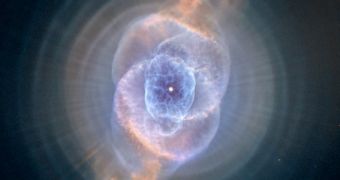A new study conducted on this image has revealed interesting structures within the Cat's Eye Nebula, a cosmic feature also known as NGC 6543. The object lies no more than 3,000 light-years away from Earth, so it started capturing the attention of astronomers centuries ago.
Famed astronomer William Herschel was the first to discover the nebula back in 1786, but other sky watchers have been monitoring it constantly ever since. The formation is produced by the star at its core, which is nearing the end of its main sequence.
The image above was first published in 2004 on the European Space Agency Portal. The NASA/ESA Hubble Space Telescope was the first to image NGC 6543 in detail, back in 1994, just three years after it launched into space. For amateur astronomers, the nebula appears as a magnitude 8.1 blob in the sky.
The Cat's Eye is cataloged as a planetary nebula. This class of structures is produced by Sun-like stars at the end of their burning cycle. Larger stars, more than 8 times heavier than the Sun, end their lives in massive supernova blasts, which can give birth to neutron stars or black holes, astronomers say.

 14 DAY TRIAL //
14 DAY TRIAL //